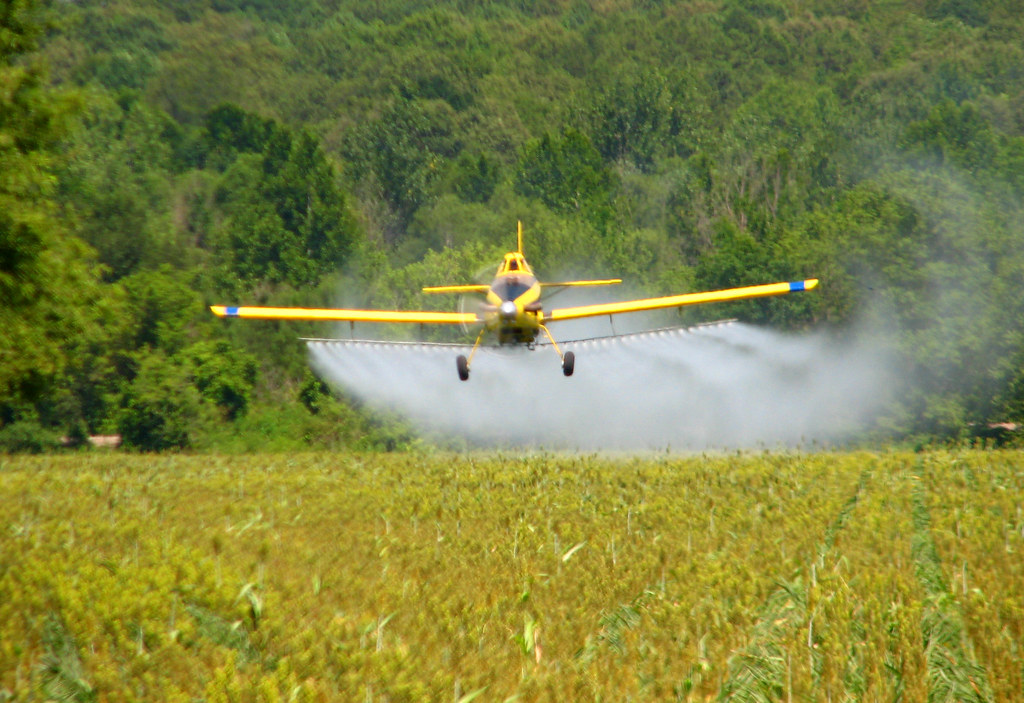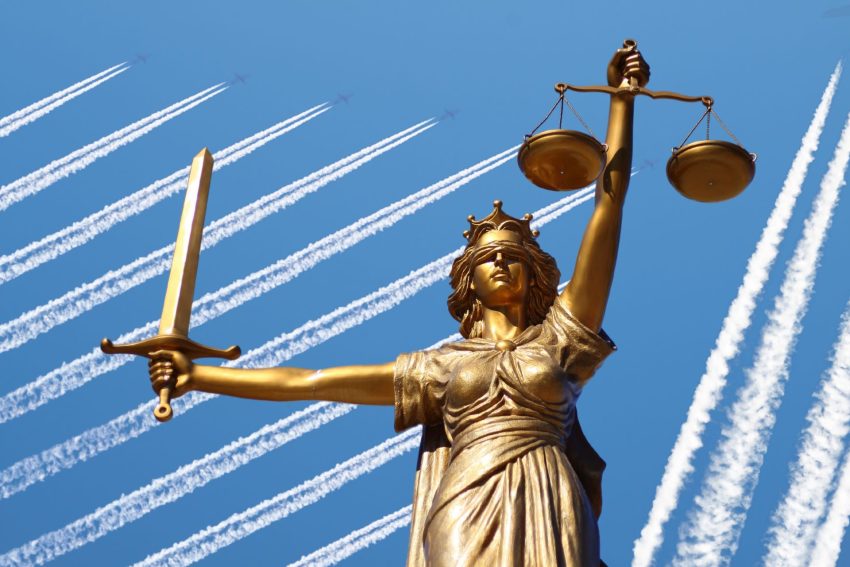In Parts I and II, we explored the origins of the chemtrail conspiracy theory and its evolution from fringe speculation to a topic gaining traction in mainstream discourse. While much of the chemtrail narrative remains steeped in unprovable claims, concerns about solar geoengineering and weather modification—technologies often conflated with “chemtrails”—have prompted real legislative action in several U.S. states. This final installment, Truth and Consequences, examines the penalties imposed by states banning these practices, the potential legal recourse for farmers whose crops and livelihoods may be harmed by such activities, and the thorny question of property rights in an era where the skies above are increasingly contested.
State Bans and Penalties: A Growing Pushback
In recent years, a wave of state legislatures has moved to restrict solar geoengineering and weather modification, driven by a mix of environmental concerns, public skepticism, and, in some cases, chemtrail-related conspiracy theories. These efforts often target stratospheric aerosol injection (SAI), cloud seeding, and other methods aimed at altering climate or precipitation patterns. Below are key examples of state actions and their associated penalties as of May 2025:
Florida: In a landmark move, Florida became the first state to criminalize geoengineering and weather modification with the passage of Senate Bill 56 (SB 56) and House Bill 477, signed into law on April 30, 2025, and effective July 1, 2025. The law classifies the “intentional injection, release, or dispersion” of chemicals or substances into the atmosphere to affect weather or climate as a third-degree felony. Violators face up to five years in prison and fines of up to $100,000 per violation. The legislation also establishes a reporting mechanism for residents to document suspected geoengineering activities, reflecting public concerns about unauthorized atmospheric tampering. Posts on social media highlight the historic nature of this law, with some users framing it as a victory against “chemtrails.”
Tennessee: In 2024, Tennessee passed a law prohibiting the “intentional injection, release, or dispersion” of chemicals into the atmosphere for the purpose of affecting temperature, weather, or sunlight intensity. The law’s passage through both legislative chambers marked a significant step in stopping geoengineering in the state, though its practical enforcement remains unclear.
Other States: As of May 2025, over 30 states are reportedly considering similar bans on geoengineering and weather modification. These efforts range from bills targeting cloud seeding to broader prohibitions on atmospheric interventions. For example, Alabama has discussed legislation to restrict weather modification, while Arizona debated Senate Bill 1432, which was amended to allow cloud seeding but prohibit other geoengineering methods like SAI. Specific penalties in these states are not detailed, but the trend suggests growing legislative momentum.
These state-level bans reflect a mix of motivations: genuine environmental concerns about the risks of geoengineering, public distrust fueled by chemtrail narratives, and political posturing. Critics argue that such laws will hinder climate research, but isn’t that the point? Proponents of the bans, including some lawmakers and activists, view them as preemptive safeguards against unauthorized or harmful interventions. No one should be allowed to steal our sunshine and get away with it.
Farmers and Legal Recourse: A Complex Battle
Farmers, whose livelihoods depend on predictable weather and healthy soil, are particularly vulnerable to the potential side effects of geoengineering. If chemicals like sulfur dioxide (SO₂) are sprayed from aircraft, this leads to acid rain, reduced sunlight, ozone depletion, and altered precipitation patterns that harm crops. While the official narrative is that there is no widespread chemical spraying via “chemtrails,” solar geoengineering proposals like SAI do involve injecting SO₂ into the stratosphere to reflect sunlight, which would cause environmental impacts and seriously impact agriculture.
If farmers believe their crops have been damaged by geoengineering activities—whether through SO₂ deposition, acid rain, reduced sunlight, or manufactured droughts—several legal avenues could be explored, though significant challenges remain:
Tort Claims for Property Damage: Farmers could pursue tort claims, such as nuisance or trespass, against entities responsible for geoengineering activities. For example, if SO₂ from SAI leads to acid rain that degrades soil or reduces crop yields, farmers might argue that their property rights have been violated. The analogy to crop dusting is apt: just as a farmer cannot legally use a crop duster to spray chemicals onto a neighbor’s land without consent, unauthorized atmospheric interventions (aka chemtrails) that deposit harmful substances could be seen as a trespass. However, proving causation is a major hurdle. Linking specific weather events or crop losses to geoengineering activities requires robust scientific evidence, which is often lacking given the complexity of climate systems.
Negligence or Strict Liability: Farmers could claim negligence if geoengineering activities were conducted recklessly or without adequate safeguards, leading to foreseeable harm like drought or reduced sunlight. Alternatively, strict liability might apply if geoengineering is deemed an “ultrahazardous activity,” as ubiquitous use of chemicals like SO₂ makes proving causation difficult, as natural weather variability and other factors (e.g., climate change) can also cause drought or reduced sunlight.
Regulatory Violations: If geoengineering activities violate state laws like Florida’s SB 56, farmers could report incidents to authorities, potentially triggering fines or criminal penalties. However, this assumes the activity is documented and attributable to a specific actor, which is challenging for high-altitude interventions that may originate outside state jurisdiction. For instance, Arizona scientist Ed Betterton noted that SO₂ released in California, Asia, or over the Pacific could circulate globally, complicating enforcement.
Federal Claims: Farmers might seek recourse under federal environmental laws, such as the Clean Air Act or Clean Water Act, if geoengineering activities result in pollution (e.g., acid rain affecting water bodies). However, federal support for geoengineering research, as seen in a 2023 White House report, suggests regulatory gaps that may limit liability unless clear violations are proven.
The core challenge for farmers is attribution. Studies indicate that SAI could reduce rainfall in some regions (e.g., 5-7% less in parts of the tropics), potentially harming crops, but distinguishing these effects from natural variability or climate change is scientifically complex. Moreover, no large-scale geoengineering programs are officially operational, and small-scale experiments (e.g., Make Sunsets’ 2022 balloon releases) involve quantities that are supposedly too small to cause significant harm. Without concrete evidence of harm and a clear defendant, legal recourse remains theoretical.
Property Rights and the Crop Dusting Analogy
The chemtrail narrative often frames geoengineering as a violation of property rights, likening it to crop dusting without consent. This analogy resonates because it highlights the lack of agency landowners have over activities in the airspace above their property. Legally, airspace is generally considered a public domain above a certain altitude, governed by federal and international regulations rather than private property rights. However, the deposition of substances like SO₂ or acid rain onto private land could be construed as a form of trespass or nuisance, especially if it causes tangible harm.

The crop dusting analogy also raises ethical questions about consent and governance. Geoengineering, particularly SAI, requires global cooperation due to its transboundary effects, yet no international framework ensures that affected communities, including farmers, have a say. The Maastricht Principles, cited in geoengineering critiques, suggest that long-term atmospheric interventions like SAI could violate the rights of future generations, but they do not directly address individual property rights. Indigenous communities, for instance, have resisted geoengineering experiments on their lands, citing violations of Free, Prior, and Informed Consent (FPIC).
Lost Revenue and Broader Implications
For farmers, crop losses due to drought, reduced sunlight, or acid rain translate directly into lost revenue, threatening livelihoods and food security. Models suggest that SAI could disrupt monsoons or cause droughts in vulnerable regions, potentially exacerbating existing climate challenges. In Arizona, where drought has reduced annual rainfall to 11-12 inches, even marginal changes in precipitation could be devastating. Beyond financial losses, the broader violation lies in the unilateral nature of geoengineering, which could impose risks on farmers without their input or benefit.
Chemtrail conspiracy theories amplify these concerns by framing geoengineering as a deliberate act of harm. Posts on social reflect this sentiment, with people celebrating state bans as a defense against toxins in the skies. Scientists argue that geoengineering research is critical to understanding its risks and benefits, but say that public distrust, fueled by conspiracy theories, complicates efforts to establish transparent regulations.
Conclusion: Navigating Truth and Consequences
The chemtrail conspiracy may still be dismissed by many, even while high-level politicians admit our skies are being sprayed, but the questions it raises about solar geoengineering and weather modification are valid. State bans like Florida’s and Tennessee’s reflect a growing backlash against perceived overreach in the skies, with penalties ranging from hefty fines to prison time. For farmers, the potential impacts of geoengineering—acid rain, reduced sunlight, or manufactured droughts—pose serious risks to crops and revenue, yet legal recourse remains elusive due to challenges in proving causation and identifying responsible parties. The crop dusting analogy underscores a deeper violation of property rights and consent, highlighting the need for robust governance to ensure that atmospheric interventions, if pursued, respect the rights of those on the ground.
For now, farmers and communities remain caught in the crosshairs of a controversy where the line between science and speculation is often as hazy as the trails above.


